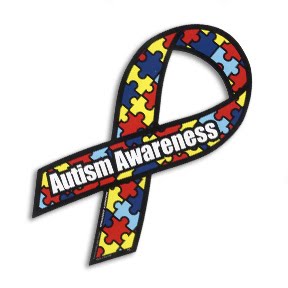April 5, 2012

What is autism?
- A neurological disorder that disrupts a child’s learning and socialization
- The third most common developmental disability
- A spectrum disorder, meaning it has a very wide range of symptoms and/or characteristics
-Children with this disorder range from very high functioning to extremely impaired
- It is 4x more prevalent in boys than girls
- Usually diagnosed during the first 3 years of a child’s life
- There is no medical test for autism
-Autism is determined only through observation and testing of a child done by a team of professionals, coupled with guardian interviews
- In order for a diagnosis to be made, child must exhibit all 3 of the following symptoms:
-Qualitative impairments in social interaction
-Qualitative impairments in communication
-Restricted, repetitive and stereotyped patterns of behavior, interests and activities
- It is estimated that 1,500,000 people in the US today have autism
- Unfortunately, to date, no single cause or cure for autism has been identified
Join the Autism Society in getting involved with the autism community this April.
April 3, 2012
What the scale shows is just a number. It does not necessarily tell you if you’re at a healthy weight. Here are 2 useful weight-wise numbers to know:
Body Mass Index (BMI)
BMI is an estimate of body fat based on height and weight. Having too much excess fat raises your risk of health problems, including:
- Type 2 diabetes
- Heart disease and stroke
- Certain types of cancer, including breast and colon
- Osteoarthritis
And, where you carry your extra weight may be important, too. For example, if it’s mostly around your middle, you’re at a higher risk for diabetes, high blood pressure and high cholesterol.
1. Calculate your BMI
To find yours, you can use an online BMI calculator. The National Heart, Lung, and Blood Institute offers one at www.nhlbisupport.com/bmi
 |
 |
Where you stand |
 |
Body mass index for adults |
 |
|
 |
|
|
 |
 |
Normal weight |
 |
18.5 — 24.9 |
 |
|
 |
|
|
 |
|
|
 |
|
2. Measure your middle
Here’s how to check your waist circumference:
- Place a measuring tape around your middle — just above your hip bones.
- Make sure the tape rests directly on your skin. Check in a mirror to see if the tape is level all the way around.
- Relax, exhale and measure your middle. The tape should be snug, but not too tight.
You are at risk if you’re a man with a measurement over 40, or a woman with measurements over 35.
Talk with your doctor about these numbers. Ask how they might affect your health.
It is important to keep in mind that these numbers are a part of a much bigger picture. Other factors — your family history, health habits, blood pressure and cholesterol levels, for example — also matter a lot.


















